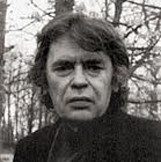At most reductive, I can tell you that Wallless Space is a book of poetry that is concerned with mortality. But it gets better than that. Wallless Space is a translation of a relatively unknown German poet—Ernst Meister—who wrote in postwar Germany (but wait, it gets better) and the book is his final collection, and (even better) it was published the same year as his death. These strange and somber circumstances turn a poet “concerned with mortality” into a retroactive authority on the subject, especially when considering lines like these:
The story
of that which was
is contained only
in ruin.
The dead, namely,
they’re incapable of
the circuitous
fable of themselves.
Even though
the grave would be
the very place
of storytelling.
One cannot help but imagine Meister relaying these lines from “the very place / of storytelling,” wherein finality allows the living language to exist.
Wallless Space was originally published in 1979 and released in a dual-language edition by Wave Books in September 2014. Translated by Graham Foust and Samuel Frederick, the book consists of short, stark stanzas—most are fewer than a dozen lines of dimeter or trimeter. Though brief, the poems are dense with contemplations about morality and a sometimes-playful look at the quotidian and the sublime. Meister surprises readers with stark, unexpected imagery and often uses repetition as a way to interrogate abstractions:
You Earth full of skulls,
what am I saying, and what
is saying?
Wallless Space is the third book in a loose trilogy that includes In Time’s Rift (Wave Books 2012) and Of Entirety Say the Sentence (forthcoming from Wave Books in 2015). In his review of In Time’s Rift, the first in the trilogy, Alex Estes notes how significantly existentialist thought and philosophy—primarily Heidegger—inform Meister’s poetry.  Heidegger haunts this collection as well, as Meister employs Heideggerian terminology and neologisms that must have been tough to translate. Lofty notions of eternity, Being, and existence fall alongside ordinary objects like houses, roosters, and stones. In their introduction, translators Foust and Frederick note the difficulty in finding English equivalents to Meister’s German diction, giving the poet’s multifaceted use of the idea of “nothingness” as an example: Nichts, Nichtigkeit, and nicht find English approximations in “nothingness,” “nothing,” “no,” and “Not.” The translators also point to moments in the text where the impossibility of finding a decent translation forced their decision to settle on a word or phrase that could only be good enough.
Heidegger haunts this collection as well, as Meister employs Heideggerian terminology and neologisms that must have been tough to translate. Lofty notions of eternity, Being, and existence fall alongside ordinary objects like houses, roosters, and stones. In their introduction, translators Foust and Frederick note the difficulty in finding English equivalents to Meister’s German diction, giving the poet’s multifaceted use of the idea of “nothingness” as an example: Nichts, Nichtigkeit, and nicht find English approximations in “nothingness,” “nothing,” “no,” and “Not.” The translators also point to moments in the text where the impossibility of finding a decent translation forced their decision to settle on a word or phrase that could only be good enough.
Such is the struggle of translation. German-American author Edith Hamilton remarked on the humility of translators who must try to “communicate an incommunicable beauty,” which entirely describes the challenges of the art form and task at hand for Foust and Frederick, who, might I add, did a damn fine job. Foust and Frederick are mindful of the culture and literary context of Meister’s work and negotiate linguistic differences with grace. The translators surrender to the rhetoricity of the original and subordinate the self (or selves) in order to communicate Meister’s vision with accuracy. When faced with the brick wall of the untranslatable, they figure out a way. For example, take the title poem of the collection, which I will include here in its entirety:
To be spirit
or dust, it’s all
the same in the universe.
Nothing is, with
which to reach the edge
of the emptiness.
That edge is
not even there.
What is is
and is bottled up, blotted out
in the wallless vessel
of space.
The phrase of importance is “bottled up, blotted out” or in the original German, aufgehoben. The translators note that this word has “a range of often contradictory meanings, including ‘abolished,’ ‘canceled out,’ ‘contained,’ ‘preserved,’ and ‘saved up’.” Not only is it the titular moment, but it also carries crucial meaning as Meister remarks on how existence both contains and overwhelms us. Foust and Frederick explain: “‘What is,’ therefore, is also lost in this infinite space, ‘abolished’ or ‘canceled out’ precisely because it is, paradoxically, ‘contained’ by the voice, the abyss of being.” As a translator, to get to such an indispensable point in the text and find an “incommunicable beauty” is unimaginable. The “bottled up, blotted out” solve encapsulates the contradictory meanings and is clever in its anagrammatic flair.
Also to the translators’ credit, the collection sounds great to an English-speaking audience. For such terse poems, each one carries a satisfying array of alliteration, assonance, rhyme, and repetition—they are dense in both phonetic quality and thought. The poems in Wallless Space are the kind that call you back and make you appreciate them anew—they demand that you pause and engage philosophically, aesthetically, spiritually.
But how can you be sure that this book is for you? If you revel in a Rilkean search for meaning. If you like to read poets’ poets. If you wish the word “decayedness” came up more. If you love Dickinson but wonder what she’d do without a trace of Romanticism and an austere German heart. If any or all of that sounds appealing, then join us in reading a fantastic (albeit neglected) poet whose concern with mortality is a pleasure to “we who are aligned / all through time . . . ” which is to say, to us all.




